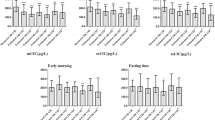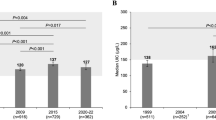Abstract
Background
Iodine fortification programs have been applied in many iodine deficient regions. Iodine excess is also unfavourable, and it is recommended to monitor iodine status by measuring urinary iodine concentration (UIC). The number of samples needed in such monitoring depends on the variation in UIC. However, it is not known if variation in UIC differs according to iodine levels.
Aim and method
We aimed to describe the effect of an iodisation program on the individual and group-based variation in UIC in spot urine samples. Group 1 (G1, n = 16) was studied before, and group 2 (G2, n = 21) was studied after an iodine fortification program was implemented. Individual urine samples were collected monthly for one year, 13 samplings.
Results
G1s (207 samples) median (interquartile range) UIC was 50 (37–67) μg/L, and G2 (265 samples) was 98 (69–139) μg/L. Median individual coefficient of variation (CV) was 38 % in G1 and 40 % in G2 (p = 0.55), whereas the group-based CV was 50 % in G1 and 53 % in G2. No trend was seen between mean UIC and variation in UIC, neither at the individual (p = 0.36) nor at the group level (p = 0.43). Based on data from both groups, approximately 100 samples were needed to reliably estimate the UIC in a population.
Conclusion
In two groups studied before and after an iodine fortification program was implemented and with different UIC levels, variation in UIC was comparable both at the individual level and according to UIC level. When mild iodine deficiency is corrected, the number of samples needed to reliably estimate the UIC in a population is unaffected.


Similar content being viewed by others
References
WHO, UNICEF, ICCIDD (2007) Assessment of iodine deficiency disorders and monitoring their elimination. 3rd edn. WHO Press, World Health Organization, 20 Avenue Appia, 1211 Geneva 27, Switzerland, World Health Organization
Speeckaert MM, Speeckaert R, Wierckx K, Delanghe JR, Kaufman JM (2011) Value and pitfalls in iodine fortification and supplementation in the 21st century. Br J Nutr 106:964–973
Laurberg P, Cerqueira C, Ovesen L, Rasmussen LB, Perrild H, Andersen S, Pedersen IB, Carle A (2010) Iodine intake as a determinant of thyroid disorders in populations. Best Pract Res Clin Endocrinol Metab 24:13–27
Andersen S, Karmisholt J, Pedersen KM, Laurberg P (2008) Reliability of studies of iodine intake and recommendations for number of samples in groups and in individuals. Br J Nutr 99:813–818
Konig F, Andersson M, Hotz K, Aeberli I, Zimmermann MB (2011) Ten repeat collections for urinary iodine from spot samples or 24-h samples are needed to reliably estimate individual iodine status in women. J Nutr 141:2049–2054
Busnardo B, Nacamulli D, Zambonin L, Mian C, Piccolo M, Girelli ME (2006) Restricted intra individual urinary iodine concentration variability in nonfasting subjects. Eur J Clin Nutr 60:421–425
Laurberg P, Jorgensen T, Perrild H, Ovesen L, Knudsen N, Pedersen IB, Rasmussen LB, Carle A, Vejbjerg P (2006) The Danish investigation on iodine intake and thyroid disease, DanThyr: status and perspectives. Eur J Endocrinol 155:219–228
Karmisholt J, Laurberg P (2008) Serum TSH and serum thyroid peroxidase antibody fluctuate in parallel and high urinary iodine excretion predicts subsequent thyroid failure in a 1-year study of patients with untreated subclinical hypothyroidism. Eur J Endocrinol 158:209–215
Wilson B, Van Zyl A (1967) The estimation of iodine in thyroidal amino acids by alkaline ashing. S Afr J Med Sci 32:70–82
Laurberg P (1987) Thyroxine and 3,5,3′-triiodothyronine content of thyroglobulin in thyroid needle aspirates in hyperthyroidism and hypothyroidism. J Clin Endocrinol Metab 64:969–974
Fraser CG, Harris EK (1989) Generation and application of data on biological variation in clinical chemistry. Crit Rev Clin Lab Sci 27:409–437
Ricos C, Iglesias N, Garcia-Lario JV, Simon M, Cava F, Hernandez A, Perich C, Minchinela J, Alvarez V, Domenech MV, Jimenez CV, Biosca C, Tena R (2007) Within-subject biological variation in disease: collated data and clinical consequences. Ann Clin Biochem 44:343–352
Zimmermann MB (2009) Iodine deficiency. Endocr Rev 30:376–408
Rasmussen LB, Carle A, Jorgensen T, Knudsen N, Laurberg P, Pedersen IB, Perrild H, Vejbjerg P, Ovesen L (2008) Iodine intake before and after mandatory iodization in Denmark: results from the Danish Investigation of Iodine Intake and Thyroid Diseases (DanThyr) study. Br J Nutr 100:166–173
Caldwell KL, Makhmudov A, Ely E, Jones RL, Wang RY (2011) Iodine status of the U.S. population, National Health and Nutrition Examination Survey, 2005–2006 and 2007–2008. Thyroid 21:419–427
Barrere X, Valeix P, Preziosi P, Bensimon M, Pelletier B, Galan P, Hercberg S (2000) Determinants of thyroid volume in healthy French adults participating in the SU.VI.MAX cohort. Clin Endocrinol (Oxf) 52:273–278
Als C, Keller A, Minder C, Haldimann M, Gerber H (2000) Age- and gender-dependent urinary iodine concentrations in an area-covering population sample from the Bernese region in Switzerland. Eur J Endocrinol 143:629–637
Andersen S, Pedersen KM, Pedersen IB, Laurberg P (2001) Variations in urinary iodine excretion and thyroid function. A 1-year study in healthy men. Eur J Endocrinol 144:461–465
Acknowledgments
Funding was kindly provided by the Nordjyske Lægekredsforenings Forskningfond, Speciallæge Heinrich Kopps Legat and Det Obelske Familiefond. Invaluable technical assistance was rendered by Ingelise Leegaard and Anne-Mette Christensen.
Conflict of interest
The authors had no financial conflict of interests.
Author information
Authors and Affiliations
Corresponding author
Rights and permissions
About this article
Cite this article
Karmisholt, J., Laurberg, P. & Andersen, S. Recommended number of participants in iodine nutrition studies is similar before and after an iodine fortification programme. Eur J Nutr 53, 487–492 (2014). https://doi.org/10.1007/s00394-013-0551-5
Received:
Accepted:
Published:
Issue Date:
DOI: https://doi.org/10.1007/s00394-013-0551-5




